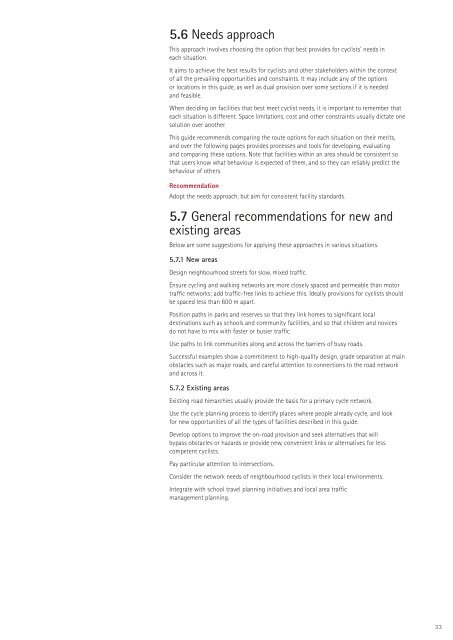Cycle network and route planning guide - NZ Transport Agency
Cycle network and route planning guide - NZ Transport Agency
Cycle network and route planning guide - NZ Transport Agency
You also want an ePaper? Increase the reach of your titles
YUMPU automatically turns print PDFs into web optimized ePapers that Google loves.
5.6 Needs approach<br />
This approach involves choosing the option that best provides for cyclists’ needs in<br />
each situation.<br />
It aims to achieve the best results for cyclists <strong>and</strong> other stakeholders within the context<br />
of all the prevailing opportunities <strong>and</strong> constraints. It may include any of the options<br />
or locations in this <strong>guide</strong>, as well as dual provision over some sections if it is needed<br />
<strong>and</strong> feasible.<br />
When deciding on facilities that best meet cyclist needs, it is important to remember that<br />
each situation is different. Space limitations, cost <strong>and</strong> other constraints usually dictate one<br />
solution over another.<br />
This <strong>guide</strong> recommends comparing the <strong>route</strong> options for each situation on their merits,<br />
<strong>and</strong> over the following pages provides processes <strong>and</strong> tools for developing, evaluating<br />
<strong>and</strong> comparing these options. Note that facilities within an area should be consistent so<br />
that users know what behaviour is expected of them, <strong>and</strong> so they can reliably predict the<br />
behaviour of others.<br />
Recommendation<br />
Adopt the needs approach, but aim for consistent facility st<strong>and</strong>ards.<br />
5.7 General recommendations for new <strong>and</strong><br />
existing areas<br />
Below are some suggestions for applying these approaches in various situations.<br />
5.7.1 New areas<br />
Design neighbourhood streets for slow, mixed traffic.<br />
Ensure cycling <strong>and</strong> walking <strong>network</strong>s are more closely spaced <strong>and</strong> permeable than motor<br />
traffic <strong>network</strong>s; add traffic-free links to achieve this. Ideally provisions for cyclists should<br />
be spaced less than 600 m apart.<br />
Position paths in parks <strong>and</strong> reserves so that they link homes to significant local<br />
destinations such as schools <strong>and</strong> community facilities, <strong>and</strong> so that children <strong>and</strong> novices<br />
do not have to mix with faster or busier traffic.<br />
Use paths to link communities along <strong>and</strong> across the barriers of busy roads.<br />
Successful examples show a commitment to high-quality design, grade separation at main<br />
obstacles such as major roads, <strong>and</strong> careful attention to connections to the road <strong>network</strong><br />
<strong>and</strong> across it.<br />
5.7.2 Existing areas<br />
Existing road hierarchies usually provide the basis for a primary cycle <strong>network</strong>.<br />
Use the cycle <strong>planning</strong> process to identify places where people already cycle, <strong>and</strong> look<br />
for new opportunities of all the types of facilities described in this <strong>guide</strong>.<br />
Develop options to improve the on-road provision <strong>and</strong> seek alternatives that will<br />
bypass obstacles or hazards or provide new, convenient links or alternatives for less<br />
competent cyclists.<br />
Pay particular attention to intersections.<br />
Consider the <strong>network</strong> needs of neighbourhood cyclists in their local environments.<br />
Integrate with school travel <strong>planning</strong> initiatives <strong>and</strong> local area traffic<br />
management <strong>planning</strong>.<br />
33

















